This Sourdough Starter is pretty darn easy to do and a great option for delicious homemade baked goods! A sourdough starter doesn’t have to be a chore, and the end result is worth the patience in the beginning. If you like homemade treats try my Sourdough Pretzels!
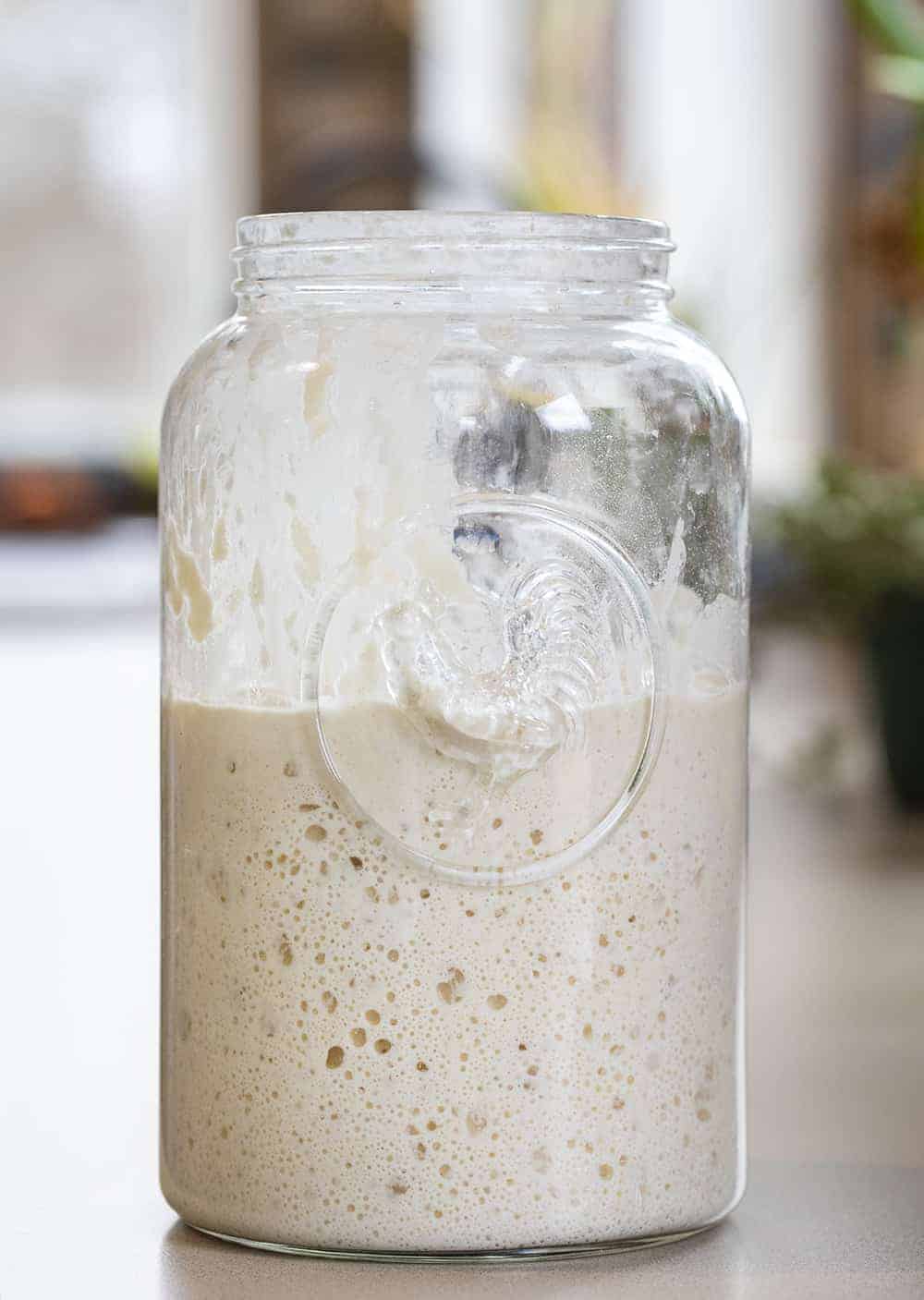
Sourdough Starter
I have to start out by saying that this is how *I* do a starter. I have watched every expert under the sun and read every book and let me tell you something… they are all different. So I have been testing and testing and retesting and using life experience to determine what works best for me. Well, I finally decided on what worked best for me, and it could not be easier and straight forward. The ingredients are simple: flour and water. And, with just two measurements to remember, the feeding is a piece of cake (or should I say bread😉) as well!

Getting your Sourdough Starter Started
Now if you want to bring science into it, the type of flour and type of water you use are important. They can produce a better product. But I am here to tell you that you can absolutely use all-purpose bleached flour from Dollar General and it will still be ok. Make sure you have the following materials and ingredients on hand:
- Jar & Lid – I prefer glass, you don’t want to use metal or plastic. If you don’t have a lid use a paper towel and rubber band. A good size jar to have on hand for a sourdough starter is a quart (32 ounces) or something close to that capacity.
- Flour – I prefer organic unbleached all-purpose, but also love whole-wheat and bread flour. Or, give rye flour a try.
- Water -Purified is best. Have chlorinated tap water (as most people do)? You can use bottled water or just set the water out uncovered for 24 hours before using it to feed your starter. This allows the chlorine to evaporate so it won’t kill the wild yeast.
That’s it for supplies! Now, let’s get to making the starter.
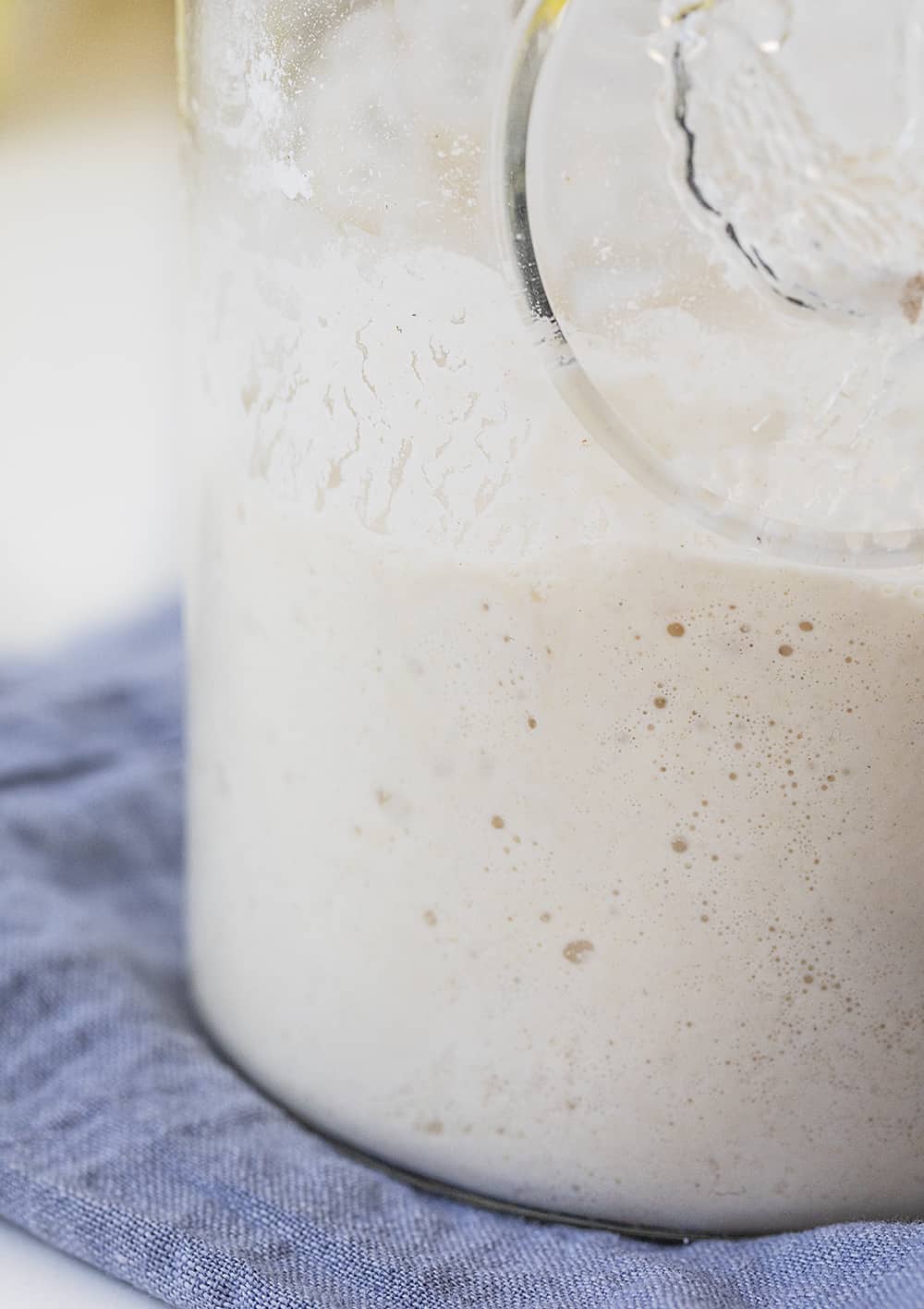
How to Make a Sourdough Starter
Remember these amounts: 1/2 cup flour and 1/4-1/3 cup water. These are the only measurements you will need to remember throughout this entire process of creating your sourdough starter. And trust me, you will use those measurements a lot with all the ‘feeding’, going on! After all, the goal is to get those microorganisms to work for that sour and fermented flavor that sourdough is known for.
To begin, add the flour and water to a jar and stir well. Try not to use a metal spoon. After all, Grandma said she always uses the handle of her wooden spoon to stir. Now gently cover the jar (do not seal it closed) and let it sit in a warm place (70°F is best) for 24 hours. The best option for a cover is a paper towel and rubber band. Or, just remember to keep the jar lid loosely sealed. Try to keep it in an area of your house that is somewhat warm. Very cool rooms tend to slow the action of a starter. Wait 24 hours before checking the mixture.

‘Feeding’ the Sourdough Starter
With sourdough starters, you will hear the term ‘feeding’. This is simply adding the flour and water to the mixture to keep the microorganisms working. Remember the measurements I told you to get ingrained in your brain? The 1/2 cup flour and 1/4-1/3 cup water is all you will need throughout the ‘feeding’ process.
Day 2: After 24 hours, check the mixture for bubbles. If you see bubbles, add the flour and the water, mixing it well, and let it sit for the next 24 hours. If you don’t see bubbles, do not get discouraged! It sometimes takes a couple of days for the science of it all to work. Just wait another day (or even two) until the first feeding.
Day 3: After another 24 hours, check for bubbles. If you do see bubbles, remove half of the starter, add the 1⁄2 cup flour and 1⁄4-1/3 cup water and stir thoroughly. Let sit 24 hours. Oh, and don’t get rid of the starter you removed! I will give you some ideas on how to use this in the end.
For the third feeding, remove half of the starter (but don’t throw it out!), and feed with 1⁄2 cup and 1⁄4 cup water, stirring thoroughly. Let sit 24 hours. (And yes, you can begin a new starter with the discard! Try adding a new kind of four! Or simply use to make crackers or pancakes.)
On days 4, 5, 6 you can feed it 2 times a day with those measurements that are sure to be memorized at this point😀. Continue this routine (discarding before feeding) until the starter is consistently bubbling and doubling in size within 8 hours of each feeding.
It is now ready to use for a perfect Sourdough Bread!
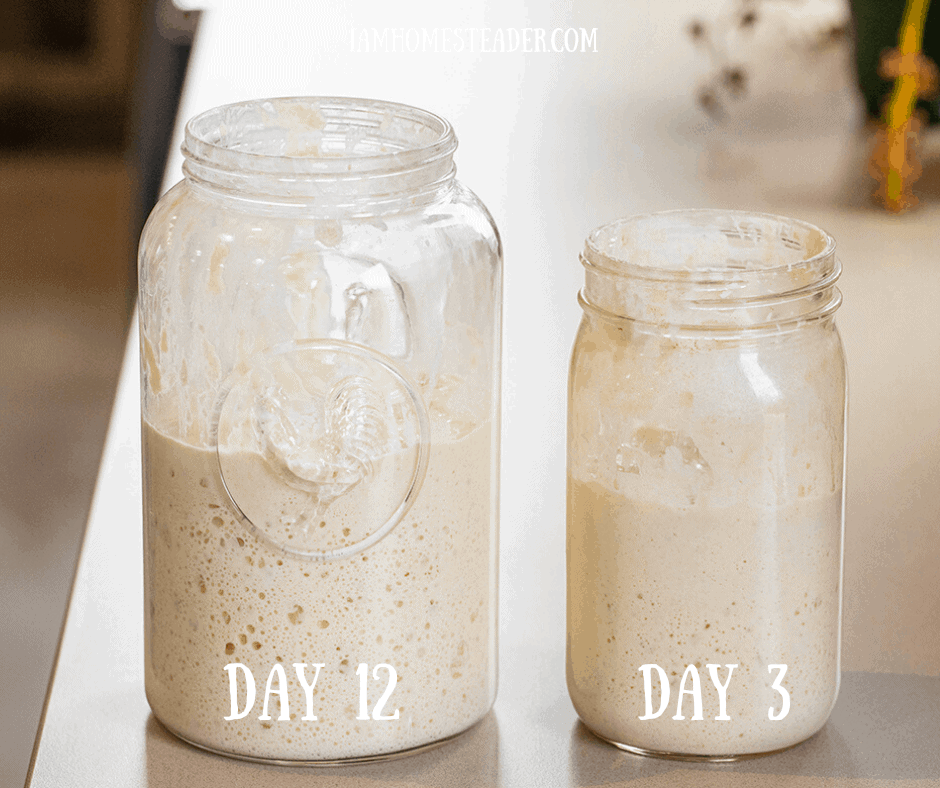
How to Store a Sourdough Starter
After all the feeding and you know you have a strong, active starter, you can store the starter in the refrigerator and feed it about once per week. When you plan to use the starter, pull it out of the refrigerator 24 hours in advance to feed it and allow it to warm up and grow.
These starters get better with age, so don’t think you have to use it right away! Sourdough starters are hearty, so they last quite a while. But, like all living things, it can get ‘sick’ or go bad. If it turns pink, red, moldy, or gets a really putrid smell, throw it out. After all, you now know how to start again!
What Flours Can You Use in a Sourdough Starter?
All grain-based flours will work beautifully in a starter. A few examples are:
- Rye
- Bread Flour
- Rice
- Whole Wheat
- Einkorn
Truesourdough.com has a great comprehensive guide to flours.
Vanilla and Bean has a great guide to Gluten-Free sourdough starter.
What to do with the Discard?
As I said, don’t throw out the sourdough starter that you remove each feeding time to make room for the starter to rise. Just make sure your sourdough starter is room temperature (about 70°F) before using it in baking. Here are some ideas on how to use (and enjoy) the excess sourdough starter.
- Sourdough Bread (not until day 6 or 7)
- Sourdough Pancakes (seriously SO GOOD!)
- Sourdough English Muffins
- Sourdough Brownies
- Sourdough Pretzels
- Cinnamon Rolls (the best!)
- Banana Bread
- Sourdough Crackers (like saltines)
- Sourdough Chocolate Chip Cookies
- Sourdough Pasta Noodles
As I mentioned, this is how *I* make a starter. King Arthur recommends 1 cup flour and 1/2 cup water and they suggest you weigh ingredients with a scale. (This is the same equivalent that I use, just doubled.) Pro Home Cooks has a great free downloadable Sourdough guide for those who really want to understand the science behind it.
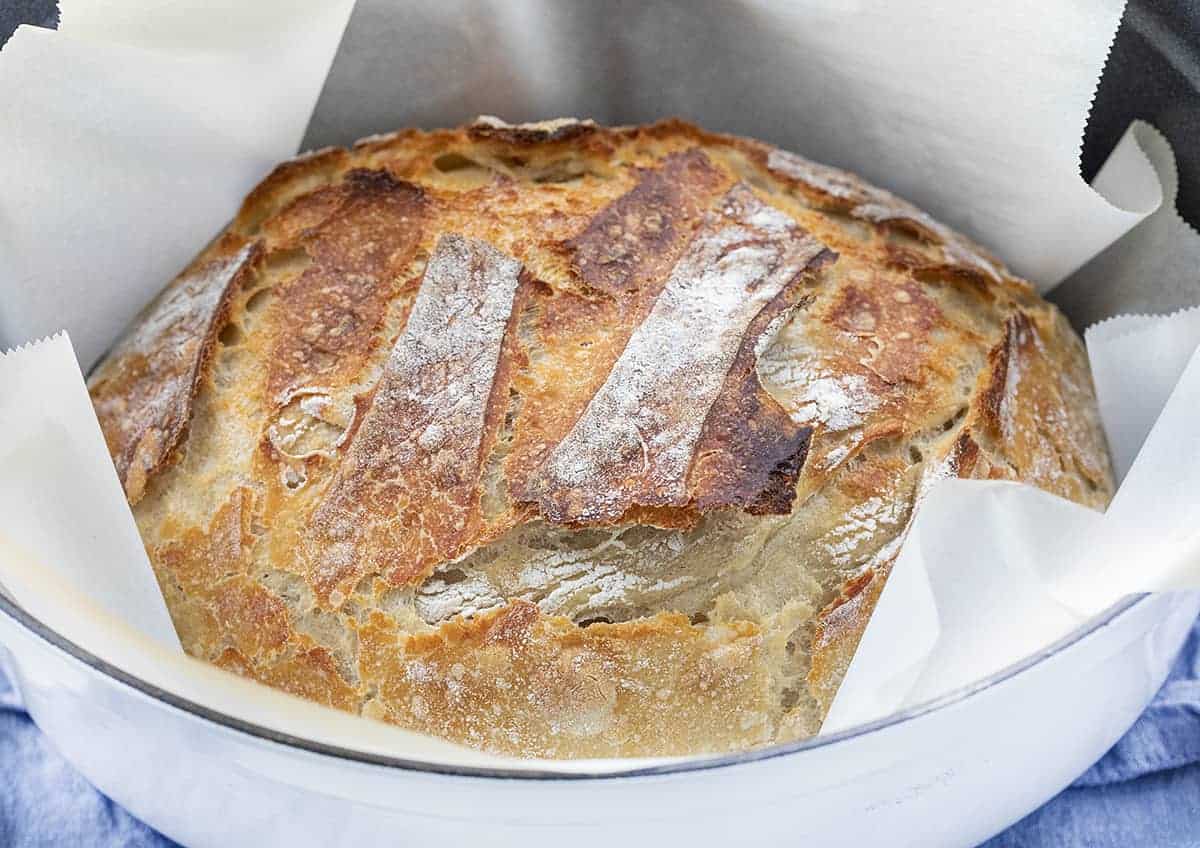
Here is the recipe for Simple Sourdough Bread!
More Sourdough Recipes

Sourdough Starter
Ingredients
- ½ cup flour, whole wheat or unbleached all-purpose
- ¼-⅓ cup water*, 75°F is ideal
- 1 glass jar, or bowl (about 32 ounces)
- 1 paper towel
- 1 rubber band
Instructions
TO BEGIN
- Start the process by adding ½ cup whole wheat flour and ¼ cup water to the jar. (If you need more flour to reach a pancake batter consistency, you can add up to ¼ cup more.)
THE FIRST FEEDING
- Stir thoroughly and cover with a towel and rubber band. Let sit for 24 hours at room temperature. (Try to keep it in an area of your house that is somewhat warm. Very cool rooms tend to slow the action of a starter.)
- After 24 hours, check the mixture for bubbles. If you see some, add ½ cup all-purpose flour and ¼-⅓cup water. If you don’t see bubbles, give it a stir and let sit 24 more hours.
THE SECOND FEEDING
- Check for bubbles again. If you do see bubbles, remove half of the starter, add ½ cup all-purpose flour and ¼-⅓ cup water and stir thoroughly. Let sit 24 hours.
THE THIRD FEEDING
- Remove half of the starter, and feed with ½ cup all-purpose flour and ¼ cup water, stirring thoroughly. Let sit 24 hours.
ADDITIONAL FEEDINGS
- On days 4, 5, 6 you can feed it 2 times a day, if you want and plan on using it.
- Continue this routine until the starter is consistently bubbling and doubling in size within 8 hours of each feeding.
- From this point (or even on day 5), you can store the starter in the refrigerator and feed it about once per week. When you plan to use the starter, pull it out of the refrigerator 24 hours in advance to feed it and allow it to warm up and grow.
Video
Notes
Did you make this recipe?
You can tag me at @iamhomesteader.
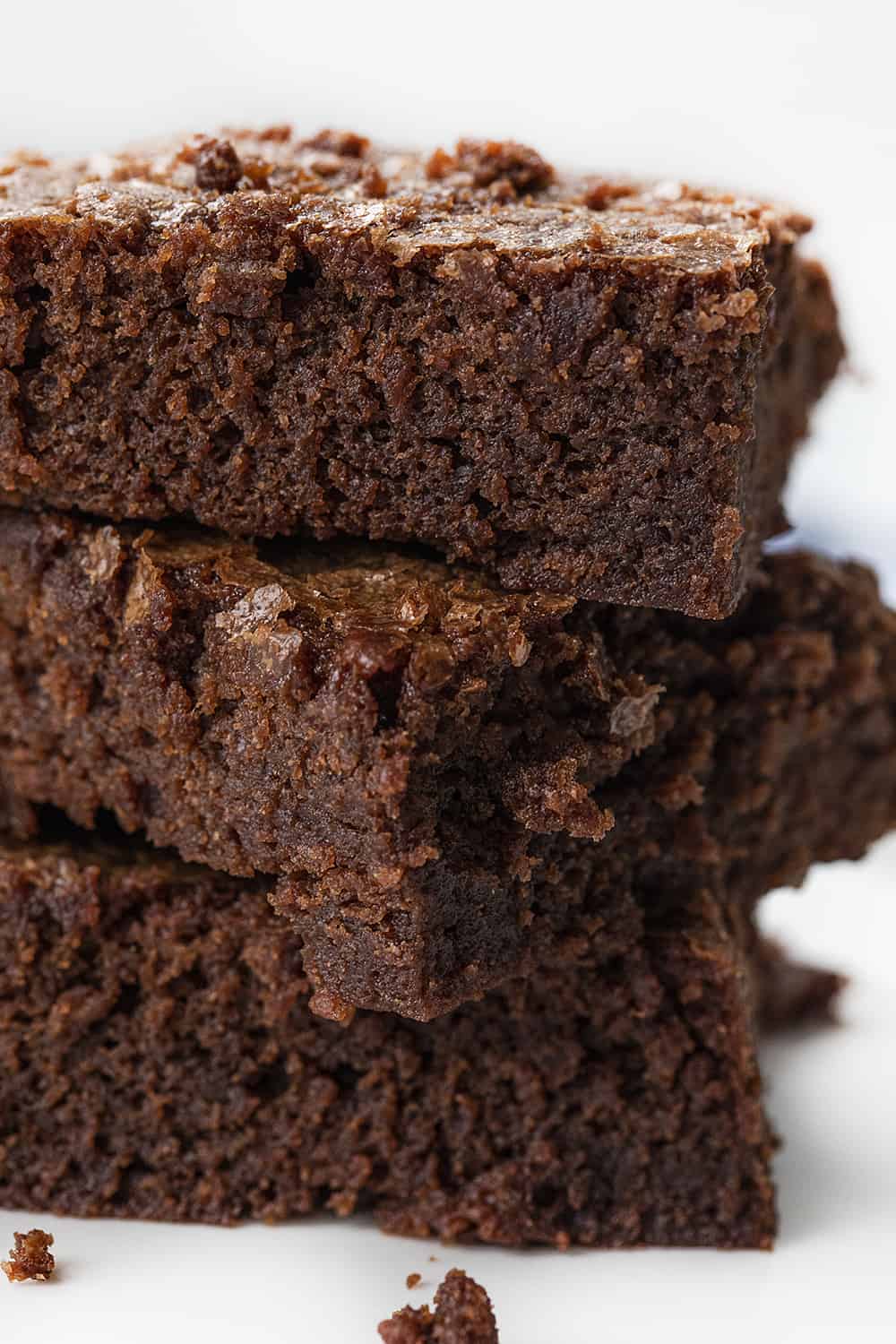
I used this starter to make seriously decadent Chocolate Sourdough Brownies!
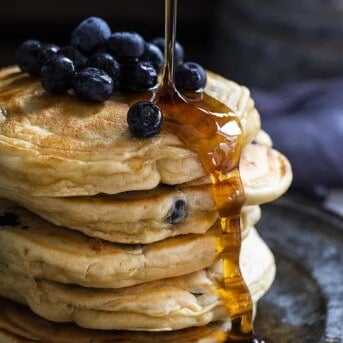
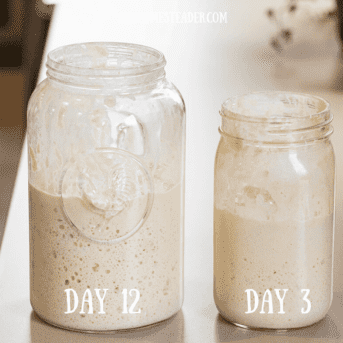
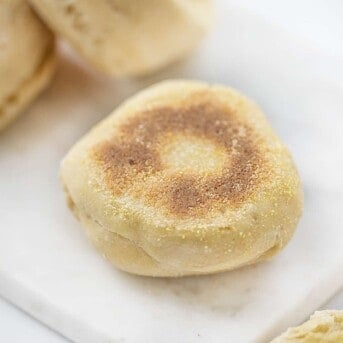
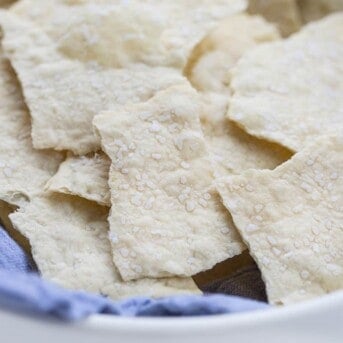
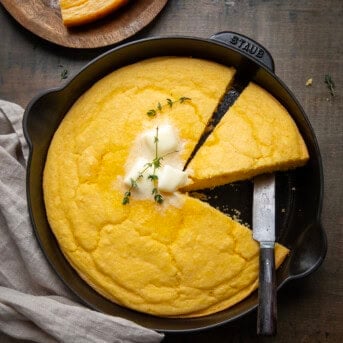


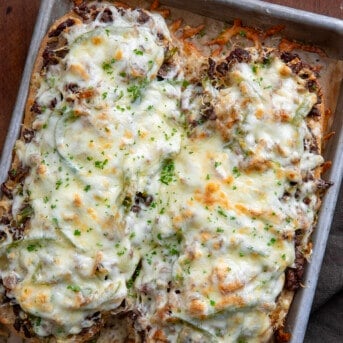
On day 5 my sourdough started went flat and water on top I tried to feed it 2 times and still… what can I do? I’m on day 7 and it hasnt rise (compared to day 1-4) and still water on top! How can I do? Thanks I’m advance!
I’m certainly not an expert… but wondering if you used tap water for your feedings? If so, the chlorine may have killed your starter.
Should I we bottled water? Mine did the same things.
Can this be made gluten free? On the day you remove 1/2 the starter, what do you do with the 1/2 you remove?
How many loaves do you get out of this starter??
It’s a Sourdough Starter, meaning that it is alive, growing, needed to be discarded, and tended to. You can get infinite loaves from 1 sourdough starter.
I have city water so after thoroughly washing potatoes I boiled them for 25ish minutes. I strained the water from those and keep it in my fridge for sourdough feeding. It works like a charm and all chlorine has been boiled out!!! I love your starter measurements. Some days it needs more liquid than others so it is great to see you don’t have an exact amount. Pancake batter consistency is a perfect description!!!!
Has anyone tried this with gluten free wheat flour before and if so how did it turn out?
I will begin the sourdough starter today. It’s now Oct2, 2023. It’s Monday and I can’t wait to make bread on day 7. I will try to make something on day 3 from discard. Thanks for an informative recipe. May check back or post pics in a few days if able. Love your humor. 🥰
My starter did great 1st 3 days. Then went flat. I fed it on the 4th day to try to get it to rise. Is there anything else I can do?
Loving this SD information. On the 2nd day & after 1st feeding the starter got 4x as big in only 4 hrs. Like its on steriods 🤣. Looks like i will be feeding it every 4 hours. UNREAL…..
So many thanks for the simplicity of this recipe…
Mary Jane
On an island in the Carribean
Love this recipe! Couldn’t believe how well it worked!!
I started my sour dough starter two days ago, about to do my second feed, and mines already busting out of the jar! I used unbleached bread flour and it’s seems to be be working hard!
Awesome!!
Hi can you make this with almond flour?
When removing half of the starter I only had about a quarter cup. What can I do with just a quarter cup?
You can save it and start discard jar, which is effectively another starter. Then when you have enough discard, you can make a bunch of the recipes I listed in the blog post. 🙂
On day three mine didn’t get bubbly. There is a liquid on the top with a strong smell.
I read somewhere to pour off the liquid with the discard. Mine is at the same stage as yours. Also read to store in the oven with th oven light on. I am trying that.
Where do you keep the discard? Another jar? Warm? How long is it good?
Do you remove half each time you feed? How do you get enough to make bread?
On day 3 of my first starter ever. It is starting to bubble pretty well. Haven’t added day 3 flour yet. Just tested for Covid. I surely can muster adding flour and water.
After several days of feeding my starter is not showing any more growth. Should I start over?
The first step (typed) begins with whole wheat flour. All flour after that is all-purpose. Is this correct, switching to all-purpose for feeding the starter after beginning with whole wheat? Thank you.
It says whole wheat OR all purpose. This is what it also says in the post “Flour – I prefer organic unbleached all-purpose, but also love whole-wheat and bread flour. Or, give rye flour a try.”
You can use whatever flour you prefer, just stick to one flour.
Can’t wait to start
Good morning!
I started mine on Monday, but I forgot to feed it yesterday…this morning it had a thick crust on top. Is all lost?
Nope! Just spoon that off and keep going! 🙂
Thank you! I’m unsure of the smell but I suppose that it is sourdough lol. Looking forward to my first loaf!
Hi, when you said add 1/2 , 1/3 cup water which is it? How much water We need to add? Thank you
I didn’t say 1/2. If you read through the recipe card every question about the ingredients is answered.
Thank you for sharing all you hard work.
I wasn’t sure what the consistency should be. I mixed the starter today, day 1, and I ended up with a lump of dough. From the photos I gathered it should be a thick liquid. Is it supposed to start out as a lump of dough?
Thanks in advance.
Hi Cheryl – it shouldn’t be a hard lump, you may need at add more water until you reach a pancake consistency.
It’s fascinating how personal and diverse the approach to making a sourdough starter can be! Your journey of trial and error, along with the amalgamation of expert advice and personal experience, has led you to a straightforward yet effective method. Your emphasis on simplicity is refreshing. I appreciate your reminder that even with various expert opinions, finding what works best for you is key. The fact that you’ve narrowed it down to flour and water, with just two simple measurements, speaks volumes about your dedication to streamlining the process. Your tips on materials and ingredients, along with your advice on water purification, are quite valuable. The clear step-by-step instructions, especially the 1/2 cup flour and 1/4-1/3 cup water measurements make this starter-making process feel accessible to anyone. And your delightful bread pun adds a sprinkle of humour!